How To Properly Clean Your Silverware Drawer And Combat The Crumbs
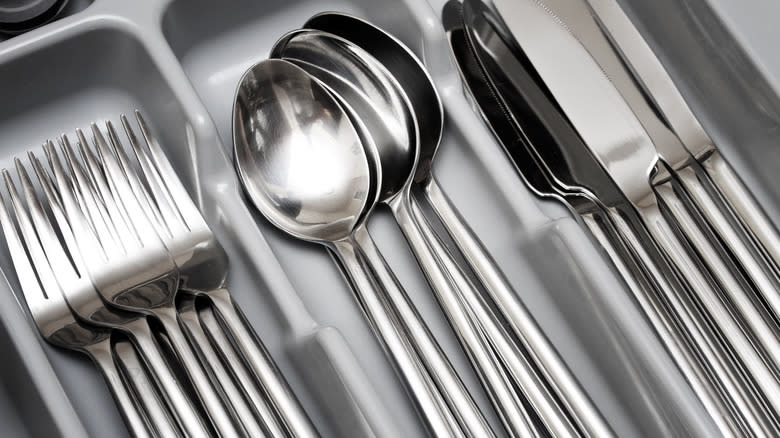
It's happened again — your silverware drawer has become dirty, and you're overwhelmed by the thought of cleaning it. You are not alone. Due to its residence underneath your kitchen counter where food is prepared, your silverware drawer is unfortunately susceptible to accumulating crumbs, dirt, and that mysterious unpleasant stickiness that raises questions. Even after you've spring cleaned your kitchen, it seems that it's only a matter of time (and meal prep) before debris sneaks its way back inside, which — when not addressed swiftly — can be inviting to pesky bugs and other critters.
Truth be told, cleaning out that drawer can be tedious, but it doesn't have to be. The good news is that there are some simple, infallible steps to cleaning your silverware drawer properly and ridding it of those crumbs and debris that somehow seem to accumulate no matter how careful you are or how closely you wash your flatware. When completed once a month, you can take that drawer from grimy to sparklingly bright easily and effectively.
Read more: The Best Way To Clean That Nasty Grease Off Of Your Kitchen Cabinets
First Empty Your Silverware Drawer
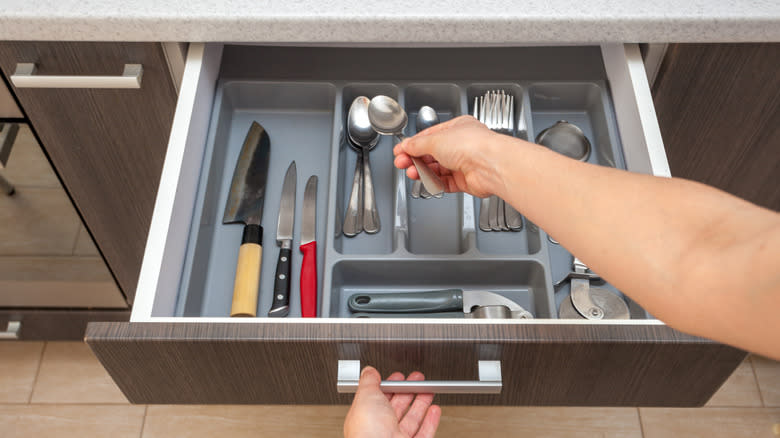
The first step to cleaning your silverware drawer is to empty it completely — remove all silverware, your utensil tray, and any drawer lining. Additionally, if you — like many of us — collect various takeout-related odds and ends, such as condiment packets and plastic-wrapped, disposable cutlery, now is the time to declutter the drawer. Decide what you want to keep and what you will use regularly (along with what you'll purge), and where you'll place it all when you're ready to refill your silverware drawer. After all, a clean cutlery drawer should be an organized one, too.
This is also a good time to determine exactly how much silverware you will return to that drawer after cleaning it. The general rule of thumb is that you should have enough cutlery in your drawer for a full day of meals for each person in your household. Any more and your tray will look cluttered; any less and it will look empty. Do you often entertain and have a lot of extra settings? Keep those in a separate drawer or your dining room sideboard so your main drawer doesn't become too crowded.
Next, Clean Your Utensil Tray
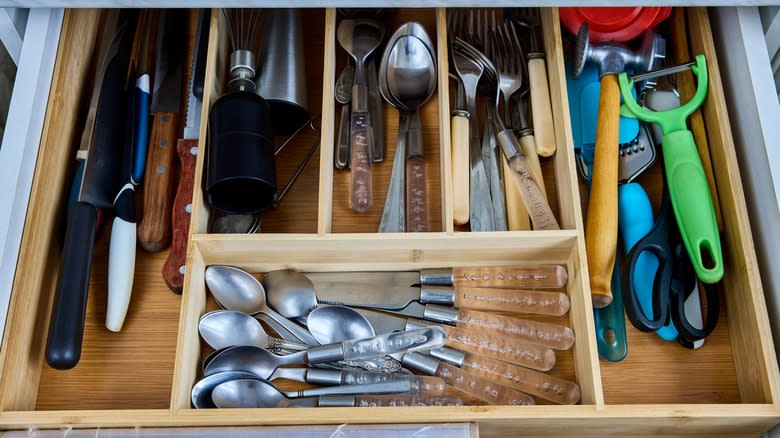
If your utensil tray is stainless steel or plastic, the cleaning process is relatively simple: You'll want to simply wipe it down with some vinegar or your favorite cleaner. For particularly dirty or sticky portions, you can also put them in the dishwasher or soak them in warm, soapy water and scrub them clean. However, it's important to note that some silverware holders can only be placed on the top rack of your dishwasher, so be sure you check your dishwasher's instructions so you don't risk ruining it.
If you have a bamboo utensil tray, you mustn't put it in the dishwasher as it may not be able to withstand the heat and detergent. Instead, the best cleaning method is scrubbing using a mix of baking soda and soapy water (one part baking soda, two parts soapy water with a mild dish soap). After cleaning with baking soda, you'll want to let your utensil holder sit for a few minutes so it can do its job before rinsing and air-drying. But be sure to let your bamboo utensil holder dry completely, which can take several hours. Otherwise, you risk developing mold if it hasn't dried thoroughly and properly.
Then Clean And Disinfect The Drawer
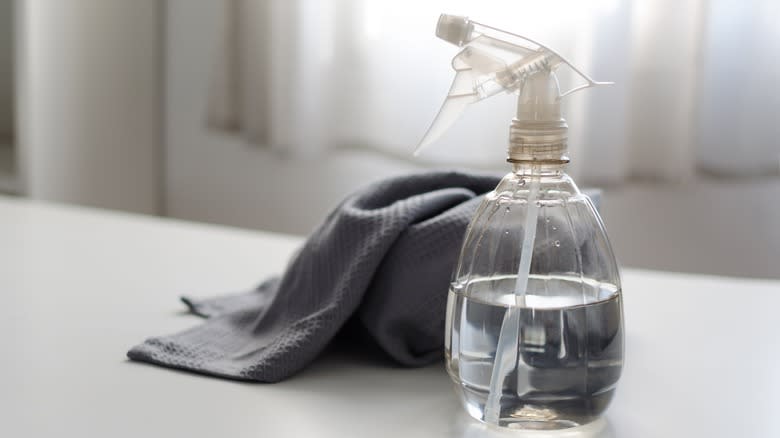
Once you've removed everything from that silverware drawer, cleaning it is relatively easy. You'll first want to use a handheld vacuum to remove any extraneous crumbs lingering in your drawer space — this will eliminate the need to tackle wet dirt later, which can be a lot harder to clean up. Then, you're free to wipe your drawer down with a slightly damp cloth to remove any stains and stickiness that may be present. To disinfect that drawer, you'll want to spray it down with a vinegar and water solution and leave it for a few minutes before wiping it clean.
One of the best vinegar hacks you can — and should — use in your kitchen is utilizing it as a non-toxic method of killing bacteria such as salmonella, which can survive for several months and may be lingering in the drawer. But be sure not to use bleach, as it can damage the wood. It's also important to note that wooden drawers can rot when exposed to too much moisture, so you'll want to keep any liquid you use (including water) to a minimum. Follow wiping with a damp rag by wiping down with a dry one; then, you'll want to let your drawer air dry completely before refilling it.
Lastly, Put Your Utensils Back And Organize Your Drawer
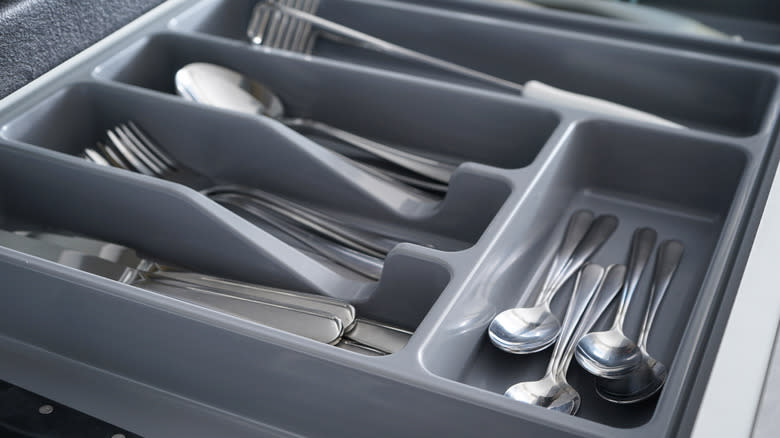
When you're ready to return your utensils to your clean, disinfected drawer and utensil tray, be intentional — how (and where) you place your utensils will make a difference in creating a streamlined, clutter-free drawer that makes grabbing the appropriate cutlery for meals quick and easy. Generally, you'll want to place your utensils in the tray with the most-used utensils on the left, down to the least-used on the right. Be sure to place them in their dividers with their handles towards you, and for uniformity, position your knives with their blades facing inwards as you would when setting your table.
If your organizer has back compartments, feel free to store your non-daily use kitchen utensils there, such as cheese knives, olive forks, and any other dinner party flatware. Repeat this whole process once a month, and you'll have an amazingly pristine silverware drawer. And save cleaning your oven and refrigerator for another day.
Read the original article on Daily Meal

